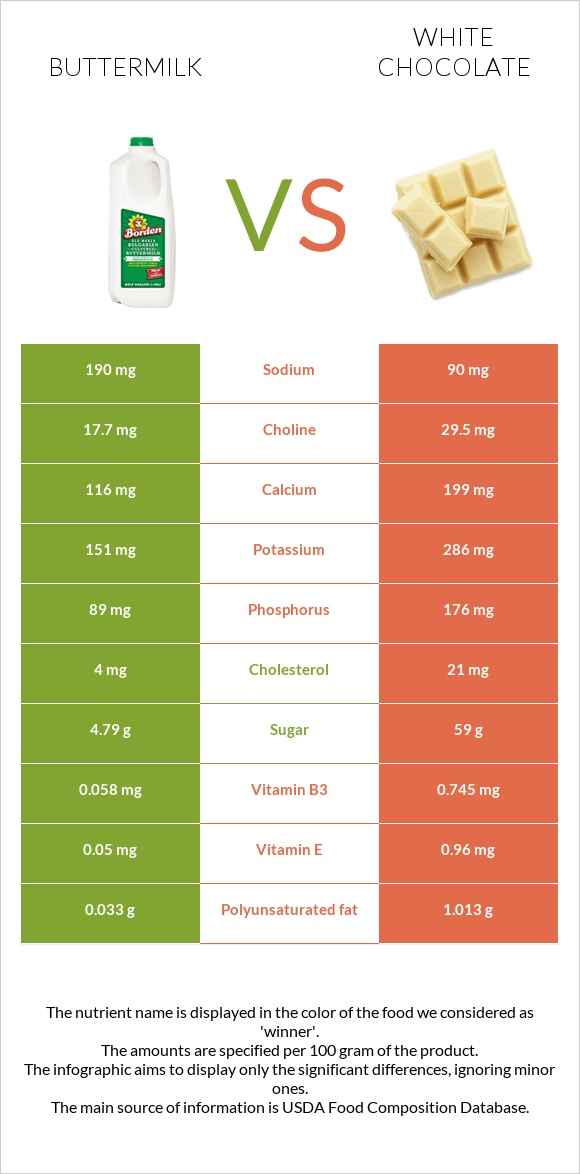Buttermilk vs. White chocolate — In-Depth Nutrition Comparison
Compare
A recap on the differences between buttermilk and white chocolate
- White chocolate is higher than buttermilk in vitamin B12, phosphorus, vitamin B2, calcium, vitamin K, vitamin B5, vitamin E, and copper.
- White chocolate covers your daily saturated fat needs 94% more than buttermilk.
- The amount of cholesterol in buttermilk is lower.
Food varieties used in this article are Milk, buttermilk, fluid, cultured, lowfat and Candies, white chocolate.
Infographic

Infographic link
Mineral Comparison
Mineral comparison score is based on the number of minerals by which one or the other food is richer. The "coverage" charts below show how much of the daily needs can be covered by 300 grams of the food.
| Contains more CalciumCalcium | +71.6% |
| Contains more PotassiumPotassium | +89.4% |
| Contains more IronIron | +380% |
| Contains more CopperCopper | +445.5% |
| Contains more ZincZinc | +76.2% |
| Contains more PhosphorusPhosphorus | +97.8% |
| Contains less SodiumSodium | -52.6% |
| Contains more ManganeseManganese | +300% |
| Contains more SeleniumSelenium | +125% |
Vitamin Comparison
Vitamin comparison score is based on the number of vitamins by which one or the other food is richer. The "coverage" charts below show how much of the daily needs can be covered by 300 grams of the food.
| Contains more Vitamin CVitamin C | +100% |
| Contains more Vitamin AVitamin A | +55.6% |
| Contains more Vitamin EVitamin E | +1820% |
| Contains more Vitamin B1Vitamin B1 | +85.3% |
| Contains more Vitamin B2Vitamin B2 | +83.1% |
| Contains more Vitamin B3Vitamin B3 | +1184.5% |
| Contains more Vitamin B5Vitamin B5 | +121.1% |
| Contains more Vitamin B6Vitamin B6 | +64.7% |
| Contains more Vitamin B12Vitamin B12 | +154.5% |
| Contains more Vitamin KVitamin K | +9000% |
| Contains more FolateFolate | +40% |
All nutrients comparison - raw data values
| Nutrient |  |
 |
DV% diff. |
| Saturated fat | 0.548g | 19.412g | 86% |
| Fats | 0.88g | 32.09g | 48% |
| Calories | 40kcal | 539kcal | 25% |
| Monounsaturated fat | 0.254g | 9.097g | 22% |
| Carbs | 4.79g | 59.24g | 18% |
| Vitamin B12 | 0.22µg | 0.56µg | 14% |
| Phosphorus | 89mg | 176mg | 12% |
| Vitamin B2 | 0.154mg | 0.282mg | 10% |
| Calcium | 116mg | 199mg | 8% |
| Vitamin K | 0.1µg | 9.1µg | 8% |
| Vitamin B5 | 0.275mg | 0.608mg | 7% |
| Polyunsaturated fat | 0.033g | 1.013g | 7% |
| Cholesterol | 4mg | 21mg | 6% |
| Vitamin E | 0.05mg | 0.96mg | 6% |
| Protein | 3.31g | 5.87g | 5% |
| Copper | 0.011mg | 0.06mg | 5% |
| Selenium | 2µg | 4.5µg | 5% |
| Potassium | 151mg | 286mg | 4% |
| Sodium | 190mg | 90mg | 4% |
| Vitamin B3 | 0.058mg | 0.745mg | 4% |
| Zinc | 0.42mg | 0.74mg | 3% |
| Iron | 0.05mg | 0.24mg | 2% |
| Vitamin B1 | 0.034mg | 0.063mg | 2% |
| Vitamin B6 | 0.034mg | 0.056mg | 2% |
| Choline | 17.7mg | 29.5mg | 2% |
| Vitamin C | 1mg | 0.5mg | 1% |
| Fiber | 0g | 0.2g | 1% |
| Vitamin A | 14µg | 9µg | 1% |
| Folate | 5µg | 7µg | 1% |
| Net carbs | 4.79g | 59.04g | N/A |
| Vitamin D | 1 IU | 0 IU | 0% |
| Magnesium | 11mg | 12mg | 0% |
| Sugar | 4.79g | 59g | N/A |
| Manganese | 0.002mg | 0.008mg | 0% |
| Tryptophan | 0.042mg | 0% | |
| Threonine | 0.141mg | 0% | |
| Isoleucine | 0.171mg | 0% | |
| Leucine | 0.313mg | 0% | |
| Lysine | 0.277mg | 0% | |
| Methionine | 0.087mg | 0% | |
| Phenylalanine | 0.171mg | 0% | |
| Valine | 0.217mg | 0% | |
| Histidine | 0.1mg | 0% |
Macronutrient Comparison
Macronutrient breakdown side-by-side comparison
Protein:
3.31 g
Fats:
0.88 g
Carbs:
4.79 g
Water:
90.13 g
Other:
0.89 g
Protein:
5.87 g
Fats:
32.09 g
Carbs:
59.24 g
Water:
1.3 g
Other:
1.5 g
| Contains more WaterWater | +6833.1% |
| Contains more ProteinProtein | +77.3% |
| Contains more FatsFats | +3546.6% |
| Contains more CarbsCarbs | +1136.7% |
| Contains more OtherOther | +68.5% |
Fat Type Comparison
Fat type breakdown side-by-side comparison
Saturated fat:
Sat. Fat
0.548 g
Monounsaturated fat:
Mono. Fat
0.254 g
Polyunsaturated fat:
Poly. Fat
0.033 g
Saturated fat:
Sat. Fat
19.412 g
Monounsaturated fat:
Mono. Fat
9.097 g
Polyunsaturated fat:
Poly. Fat
1.013 g
| Contains less Sat. FatSaturated fat | -97.2% |
| Contains more Mono. FatMonounsaturated fat | +3481.5% |
| Contains more Poly. FatPolyunsaturated fat | +2969.7% |





